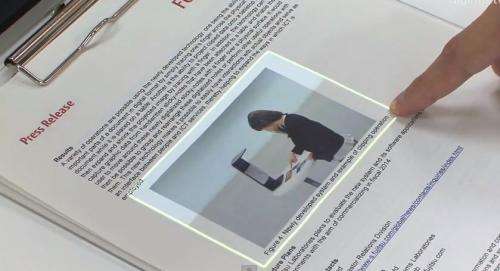(Phys.org) —Fujitsu Laboratories has unveiled a new twist in touch-screen technology—an overhead projector/camera device that turns printed pages into interactive media. Called the Fingerlink Interaction System, it lets users highlight text or images using a single finger then drag them to one side for future use; tap on web-links and have web pages open, or use their fist to animate virtual 3D objects.
Recognizing that tablet computers and smartphones have not yet made real paper obsolete, engineers at Fujitsu have created a device that allows people to use printed products in ways they've become accustomed to doing with electronic media. The system works by utilizing standard computer cameras, an overhead projector, image processing and electronics to run it all. In practice, it looks like a cylinder, about two feet tall that sits on the edge of a table. At the top of the cylinder is an overhang that contains the electronics, cameras and projector. To use the system, a person lays a piece of paper—or even an open book—on the table and allows the system to recognize it, which appears to happen very quickly. Next, the user reaches out a hand and extends a single finger for using as an interactive device. The system scans the finger noting its size, orientation, and even its color. This is to allow it to differentiate it from all other objects on the table. Once the system learns all it needs to know about the finger, the user can use it to highlight text on the printed page, graphics or pictures. Dragging them off to the side causes the highlighted material to be captured as a single unit and held for later use. The system also recognizes web page addresses and highlights them automatically. Tapping them with the finger causes the associated web page to be opened and stored in the area next to the printed material. It can also overlay information over the top of the printed material if desired.
The engineers at Fujitsu also added another separate feature to the system that allows a user to manipulate virtual 3D objects in virtual space using their fist. At the demonstration, reps for the company indicated that the system is not yet ready for sale, but plan to make it so sometime next year. They added that they believe such technology would be very useful as a demonstration device, for travel agencies, for example, or as a way to allow users to interact with and fill out forms at governmental offices.
More information: via Diginfo
© 2013 Phys.org























